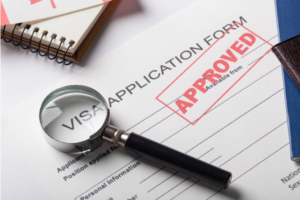How to Expedite a K-1 Fiancé Visa: Guide to Faster Processing
Waiting for a K-1 fiancé visa can feel like an eternity. As you and your partner eagerly anticipate being together, the thought of a visa overstay can loom large. With U.S. immigration processing times currently fluctuating between 10 to 16 months in 2025, many couples search for ways to speed up the process. This guide provides an updated look at how to expedite a K-1 visa, outlining the criteria, the exact steps to follow, and the importance of professional legal guidance. Our goal is to empower you with the knowledge to navigate this complex journey and bring your loved one to the U.S. sooner.
Understanding the K-1 Fiancé Visa Process
The K-1 visa, often called the fiancé visa, allows the foreign fiancé of a U.S. citizen to enter the country to marry. Once in the U.S., the couple has 90 days to get married. The process begins with the U.S. citizen filing Form I-129F, Petition for Alien Fiancé(e), with U.S. Citizenship and Immigration Services (USCIS).
- 2025 Processing Times: As of mid-2025, USCIS processing for Form I-129F is estimated to take between 8 and 11 months. This is just the first step. After USCIS approval, the case moves to the National Visa Center (NVC) for a few weeks, followed by a wait for a consular interview abroad, which can take an additional 4 to 8 weeks depending on the embassy’s workload.
To avoid delays, it’s more critical than ever to submit a complete and accurate I-129F petition. USCIS has a new, mandatory version of the form as of May 1, 2025, with stricter formatting requirements.
Unlock the Answers to Your Immigration Questions. Download our FREE Q&A Guide.
Qualifying for a K-1 Visa Expedite Request
Immigration authorities grant expedite requests only under specific, extraordinary circumstances. Therefore, you must provide compelling evidence that your situation meets one of the following criteria:
- Extreme Humanitarian Reasons: This is the most common reason for approval. Examples include a life-or-death medical emergency, a serious illness requiring the care of the U.S. citizen or fiancé, or an urgent family matter (e.g., a death).
- Severe Financial Hardship: Expediting may be considered if a significant financial loss would be incurred by a U.S. company or person without the immediate presence of the fiancé.
- Urgent U.S. Government Interest: This includes circumstances like a military member’s deployment or other cases deemed to be in the national interest.
However, it is important to note that a pending wedding date or emotional hardship alone is generally not sufficient reason to grant expedition.
How to Expedite Your K-1 Visa Petition

There are two main stages where you can request an expedite.
1. Expediting the I-129F Petition at USCIS
The first opportunity is while your I-129F petition is pending with USCIS. To submit a request:
- Contact USCIS: Call the USCIS Contact Center at 1-800-375-5283. Have your petition receipt number ready.
- Provide Evidence: You will be asked to submit evidence that supports your claim for expedited processing. This might include a letter from a doctor detailing a medical emergency, financial statements, or military orders. Strong, specific, and well-documented evidence is critical.
- Follow Up: Once the request is made, monitor your case status and be prepared to respond to any further inquiries. USCIS reviews each request on a case-by-case basis, and an expedite is never guaranteed.
To expedite the I-129F petition, one files an expedited request I-129f with USCIS. The following are the guidelines:
2. Expediting Your Case at the National Visa Center (NVC)
After USCIS approves the I-129F, your case is sent to the NVC. Then, you can request an expedite at this stage by:
- Emailing NVC: Send an email to NVCExpedite@state.gov. The subject line should include “Request for NVC Expedite” along with your case number.
- Explain Your Case: In the email, clearly explain the reason for your request and attach all supporting documents.
- Await a Decision: The NVC will review your request and, if approved, will fast-track your case to the appropriate embassy or consulate for the visa interview.
Smart Strategies to Avoid Delays

While you can’t control the government’s processing speed, you can control the quality of your application to prevent unnecessary delays.
- Be Meticulous with Documentation: The number one cause of delays is incomplete or inaccurate paperwork. Ensure all forms are filled out correctly, signed, and that every required document is included. A Request for Evidence (RFE) can add months to your timeline.
- Organize Your Evidence: Clearly present evidence of your relationship (photos, chat logs, travel itineraries) and your financial support. As of 2025, USCIS and consular officers are scrutinizing these documents more closely than ever.
- Consult an Immigration Lawyer: The process of expediting a visa is complicated and risky. An experienced immigration attorney can assess your eligibility, help you gather strong evidence, and draft a persuasive request, significantly increasing your chances of success.
Alternative Visa Options
If an expedite request is not an option or is denied, you may have other pathways to consider.
- CR-1 Spousal Visa: If you are already married, the CR-1 visa may be a better alternative. While the processing time is comparable to or even longer than the K-1 visa (13 to 26 months as of mid-2025), your spouse will enter the U.S. as a permanent resident with a green card, avoiding the adjustment of status process and related costs that are required for K-1 visa holders after marriage.
- Visitor Visa: In some cases, a foreign fiancé may be able to visit the U.S. on a tourist visa while the K-1 is pending. However, this is generally a risky option as immigration officials may suspect an intent to immigrate and deny entry.
Final Thoughts & Call to Action

The journey to reunite with your partner is a personal and emotional one. Expediting a K-1 visa is challenging, but with the right strategy and strong evidence, it is possible. Understanding the specific criteria and following the correct procedures for both USCIS and the NVC are paramount.
At Passage Immigration Law, we are passionate about helping couples navigate the complexities of U.S. immigration. Our team can help you evaluate your options, build a strong case, and present your expedited request in the most compelling light.
Don’t let a long wait keep you apart. Contact us today for a consultation and take the next step toward being together.
Disclaimer: This article offers general legal information, not legal advice. Do not rely upon this information without seeking legal counsel. If you need legal advice, you may contact us directly to speak with an attorney. We disclaim all liability with respect to actions taken based on any information presented. Every case is different, and outcomes will vary depending on the unique facts and legal issues of your case.







